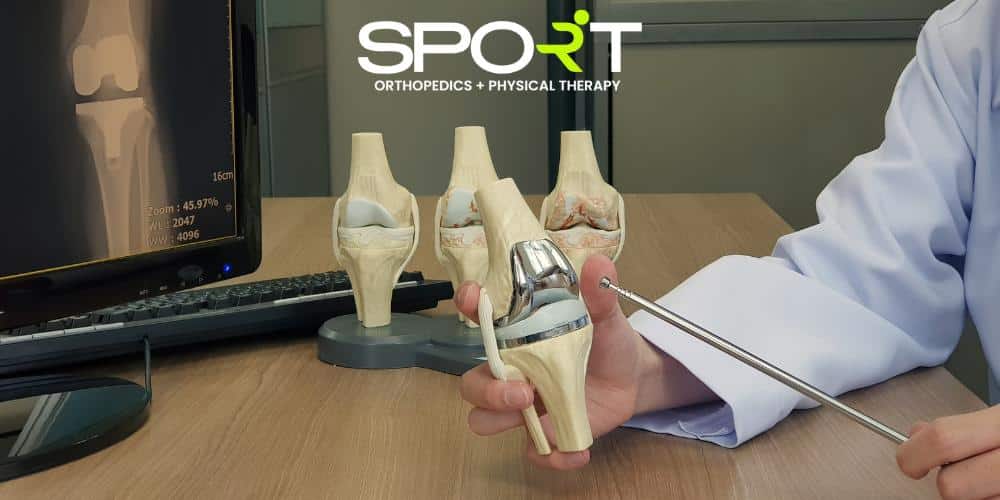Knee Replacement Surgery Prosper, TX
Knee Joint Replacement in Prosper
Home » Knee Replacement Surgery Prosper
Considering knee replacement surgery in Prosper, TX? Look no further than SPORT Orthopedics + Physical Therapy. Our clinic specializes in providing comprehensive orthopedic care, including advanced knee replacement procedures tailored to your individual needs. With a dedicated team of experienced surgeons and therapists, we are committed to helping you regain mobility, reduce knee pain, and restore your quality of life.
To schedule an appointment with us, please call our office at 469-200-2832 today.
What Is a Knee Joint Replacement?
A knee replacement surgery is a surgical procedure designed to relieve pain and restore function in a damaged or diseased knee joint. During the procedure, the surgeon removes the damaged cartilage and bone from the knee joint and replaces it with artificial components made of metal alloys, high-grade plastics, and polymers.
This artificial joint, or prosthesis, mimics the natural movement of the knee, allowing for improved mobility and reduced pain. Knee joint replacement surgery is typically recommended for individuals with severe arthritis, anterior cruciate ligament or posterior cruciate ligament injury, or other conditions that have not responded to conservative treatments. It can significantly improve quality of life by enabling patients to engage in everyday activities with greater ease and comfort.

What Are the Types of Knee Replacements?
Knee replacement surgery, also known as knee arthroplasty, is a common procedure that relieves pain and restores function in individuals with severe knee arthritis or other knee conditions. There are several types of knee replacements tailored to meet the specific needs of each patient.
Partial Knee Replacement
Partial knee replacement, also known as unicompartmental knee replacement, is a less invasive option compared to total knee replacement. In partial knee replacement, only the damaged part of the knee joint is replaced with implants, preserving the healthy portions of the knee.
This procedure is ideal for patients with isolated damage to one compartment of the knee, typically the medial (inner) or lateral (outer) compartment. It offers advantages such as faster recovery, less blood loss, and preservation of natural knee anatomy.
Total Knee Replacement
Total knee replacement surgery is the most common type of knee replacement surgery. In this procedure, the damaged cartilage and bone from both the femur (thigh bone) and tibia (shinbone) are replaced with artificial implants made of metal, plastic, or a combination of both. The patella (kneecap) may also be resurfaced with a plastic component. It is suitable for patients with widespread arthritis or significant damage to multiple parts of the knee joint.
Bilateral Knee Replacement
Bilateral knee replacement involves replacing both knees during a single surgical procedure. This approach is suitable for patients who have severe arthritis in both knees, allowing them to undergo one recovery period instead of two separate surgeries. This can help relieve pain in both knees.
While bilateral knee replacements can offer significant benefits in terms of convenience and rehabilitation, they also pose higher risks compared to unilateral knee replacement, including increased blood loss and longer operative time.
Robotic Knee Replacement
Robotic knee replacement surgery is a relatively newer advancement in knee arthroplasty. This technology utilizes a robotic arm guided by a surgeon to precisely position the implants based on preoperative planning and real-time feedback.
Robotic assistance offers enhanced accuracy, improved implant alignment, and potentially better functional outcomes than conventional knee replacement techniques. It allows for personalized implant placement tailored to the patient’s unique anatomy, potentially leading to improved longevity and reduced risk of complications.
What Are the Advantages of Knee Replacement Surgery?
Knee replacement surgery offers several advantages for individuals suffering from severe knee pain and limited mobility due to conditions like osteoarthritis, rheumatoid arthritis, or injury. These advantages are as follows.
One of the primary benefits of knee replacement surgery is significant pain relief. By replacing damaged cartilage and bone with artificial components, the procedure can relieve knee pain that restricts daily activities, allowing individuals to regain their quality of life.

Knee replacement surgery can restore mobility and function to the knee joint, enabling patients to perform daily tasks, such as walking, climbing stairs, and participating in recreational activities, with greater ease and comfort. This enhanced mobility enhances independence and overall well-being.
With reduced pain and improved mobility, patients often experience a substantial improvement in their overall quality of life. They can engage in activities they previously avoided due to pain or limited mobility, leading to increased physical activity, social interaction, and a more fulfilling lifestyle.
Modern advancements in materials and surgical techniques have significantly improved the durability of knee implants. While individual results may vary, many patients can expect their knee replacements to last for 15 to 20 years or more, providing long-term relief and functionality.
Minimally invasive knee replacement techniques, such as robotic-assisted surgery, offer advantages such as smaller incisions, reduced blood loss, and faster recovery times compared to traditional surgery, allowing patients to return to their normal activities more quickly.
Dangers of Delaying Knee Replacement Surgery
Delaying knee replacement surgery can lead to several potential dangers and consequences for individuals experiencing severe pain and limited mobility.
- Increased pain and discomfort
- Worsening joint damage
- Functional decline and mobility limitations
- Increased risk of complications
- Psychological impact
What to Expect During Knee Replacement Surgery
Most knee replacement surgeries are performed under either general anesthesia, where the patient is unconscious, or regional anesthesia, such as a spinal or epidural block, which numbs the lower body while the patient remains awake. The anesthesia choice depends on various factors, including the patient’s overall health and preferences.
Once the anesthesia takes effect, the surgeon makes an incision over the knee to access the joint. During the procedure, damaged cartilage and bone are removed from the knee joint surfaces. The surgeon then replaces these with artificial components made of metal, plastic, or ceramic, customized to fit the patient’s anatomy. The goal is to restore smooth joint movement and stability.
After surgery, patients are transferred to a recovery area where vital signs are monitored as they wake from anesthesia. Pain management medications are administered as needed to ensure comfort. Physical therapy typically begins within a day of surgery to promote knee movement, muscle strength, and mobility. Patients may use assistive devices like walkers or crutches during the initial stages of recovery.
How Long Does a Knee Replacement Take?
A knee replacement surgery typically takes around one to two hours to complete. The procedure involves removing damaged portions of the knee joint and replacing them with artificial components made of metal and plastic. A serious knee injury or condition may take longer to treat.
Factors such as the patient’s overall health, the extent of damage to the knee, and the surgical approach employed can influence the duration of the surgery. Additionally, post-operative care and rehabilitation are essential for ensuring successful recovery and optimal function of the new knee joint.
Knee Replacement Recovery Timeline
After the procedure, knee replacement surgery recovery can take anywhere from 6 months to a year for a full recovery. However, some knee surgery cases require longer recovery periods.
Immediately after surgery: Patients typically spend a few days in the hospital for monitoring and initial recovery. Physical therapy begins during this time to promote mobility and prevent stiffness.
Weeks 1-2: During the first couple of weeks post-surgery, focus is on managing pain and swelling while gradually increasing mobility. Patients may use assistive devices like crutches or walkers and continue with physical therapy both in the hospital and at home.

Weeks 3-6: By this point, many patients are able to move around with less assistance and may transition to using a cane instead of crutches. Physical therapy continues to progress, focusing on strengthening the muscles around the knee and improving range of motion.
Months 2-3: Most patients start to experience significant improvement in mobility and reduced pain. They can gradually increase their activity levels, incorporating low-impact exercises like swimming or stationary cycling to further strengthen the knee.
Months 3-6: By the end of the third month, many patients are able to return to light activities such as walking, gardening, or golfing. Physical therapy may continue to address any remaining issues and to ensure optimal recovery.
6 months onwards: Full recovery can take up to a year or more, with continued improvement in strength and mobility. Patients can gradually return to more demanding activities such as hiking, biking, or playing sports, but should always listen to their bodies and avoid overexertion.
What Can Patients Expect One Year After Knee Replacement Surgery?
One year after knee replacement surgery, patients can typically expect significant improvement in mobility, reduced pain, and increased function compared to pre-surgery. Many individuals can return to activities they enjoy, such as walking, hiking, biking, and even some sports, though high-impact activities may still be limited.
Strength and flexibility continue to improve over time, and while some mild stiffness or discomfort may still be present, it’s often manageable. Regular exercise and continued adherence to any post-surgery recommendations from healthcare professionals and your physical therapist can help maintain the benefits of the surgery for the long term.
What Permanent Restrictions Are There After Knee Replacement?
After knee replacement surgery, there may be some permanent restrictions to consider. While most patients can expect significant improvement in mobility and function, high-impact activities such as running, jumping, and certain sports may need to be avoided to prevent excessive wear and tear on the prosthetic knee joints.
Additionally, activities that involve twisting or heavy lifting may also be restricted to protect the new knee joint from strain or dislocation. However, each individual’s limitations can vary based on factors such as the type of implant used, overall health, and surgeon’s recommendations.
Knee Joint Replacement FAQs
How Long Do Knee Replacements Last?
The longevity of knee replacements varies from person to person, but on average, modern knee replacements are designed to last 15 to 20 years or more with proper care and maintenance. Factors such as the patient’s age, activity level, weight, overall health, and the type of implant used can influence the lifespan of the replacement joint.
Advances in materials and surgical procedure continue to improve the durability of knee replacements, but eventual wear and tear over time may necessitate revision surgery to replace or repair the prosthetic joint. Regular follow-up appointments with healthcare providers and adherence to post-surgery recommendations can help maximize the lifespan of a knee replacement.
What Does a Knee Replacement Cost in Prosper?
The cost of knee replacement surgery can vary widely depending on factors such as geographic location, the specific hospital or surgical facility, the surgeon’s fees, the type of knee implants used, and any additional medical services required.
In the United States, the average cost of a knee replacement surgery, including hospital stay and fees for the surgeon and anesthesiologist, ranges from $20,000 to $60,000 or more without insurance coverage. However, with insurance coverage, out-of-pocket costs for patients can vary significantly based on their insurance plan and deductible.
What Is the Best Sitting Position After a Knee Replacement?
After a knee replacement, the best sitting position is one that keeps the new knee elevated and supported to reduce swelling and promote circulation. Ideally, patients should sit with their knees slightly bent and supported by a cushion or footstool to keep the knee at or slightly below the level of the hip.
Avoiding prolonged periods of sitting with the knee fully bent or crossed over the opposite leg can help prevent stiffness and discomfort. Additionally, using a firm, supportive chair with proper back support can help maintain good posture and reduce strain on the knee joint. It’s essential to listen to your body and adjust your sitting position as needed to minimize pain and maximize comfort during the recovery process.
What Are the Alternatives to Knee Replacement?
Most knee pain is treated with conservative options before resorting to surgery. Some of these alternatives to knee replacement surgery include the following.
Non-surgical treatments: These may include lifestyle modifications, physical therapy, medications such as nonsteroidal anti-inflammatory drugs (NSAIDs) or corticosteroid injections, and the use of assistive devices like braces or orthotics to alleviate pain and improve mobility.
Knee arthroscopy: In cases of minor knee damage or certain types of injuries, arthroscopic surgery may be an option. This minimally invasive procedure involves small incisions through which a tiny camera and surgical tools are inserted to repair or remove damaged tissue within the knee joint.
Osteotomy: In some cases, particularly for younger patients with early-stage osteoarthritis, osteotomy may be considered. This surgical procedure involves realigning the bones around the knee joint to shift weight away from the damaged area, reducing pain and delaying the need for knee replacement.
Regenerative medicine: Emerging treatments such as platelet-rich plasma (PRP) injections, stem cell therapy, and growth factor injections aim to stimulate the body’s natural healing processes and promote tissue regeneration in the knee joint. While research is ongoing, these therapies may offer potential benefits for some patients, particularly those with mild to moderate knee arthritis.
Can Patients Run After Knee Replacement Surgery?
While some patients may be able to run after knee replacement surgery, it’s generally not recommended due to the high-impact nature of running, which can put significant strain on the artificial joint and increase the risk of wear and loosening over time.
Running places considerable stress on the knees and may lead to premature knee prosthesis failure or other complications. However, individual outcomes vary, and some patients may be cleared for low-impact activities like jogging or brisk walking after consulting with their surgeon and completing a comprehensive rehabilitation program.
How Long Until You Can Walk Normally After Knee Replacement?
Most patients can begin walking with assistance, such as a walker or crutches, within a day or two after knee replacement surgery. As the healing process progresses and physical therapy advances, patients typically regain the ability to walk independently within a few weeks to a couple of months post-surgery.
However, “walking normally” can vary from person to person, with some individuals achieving a near-normal gait pattern sooner than others. Full recovery and the ability to walk comfortably without assistance may take several months, with continued improvement over the following year.
Contact SPORT Orthopedics + Physical Therapy for Knee Replacement in Prosper
At SPORT Orthopedics + Physical Therapy in Prosper, TX, we understand the impact that knee pain and mobility limitations can have on your daily life. Our team of experienced orthopedic surgeons and physical therapists in Prosper are dedicated to providing personalized care and comprehensive treatment options, including knee replacement surgery, to help you regain function and get back to the activities you love.
From the initial consultation through post-surgical rehabilitation, we prioritize your comfort, safety, and long-term success. Whether you’re considering knee replacement surgery or exploring alternative treatments, we’re here to guide you every step of the way. Contact us today to schedule an appointment and take the first step toward a healthier, more active life.


